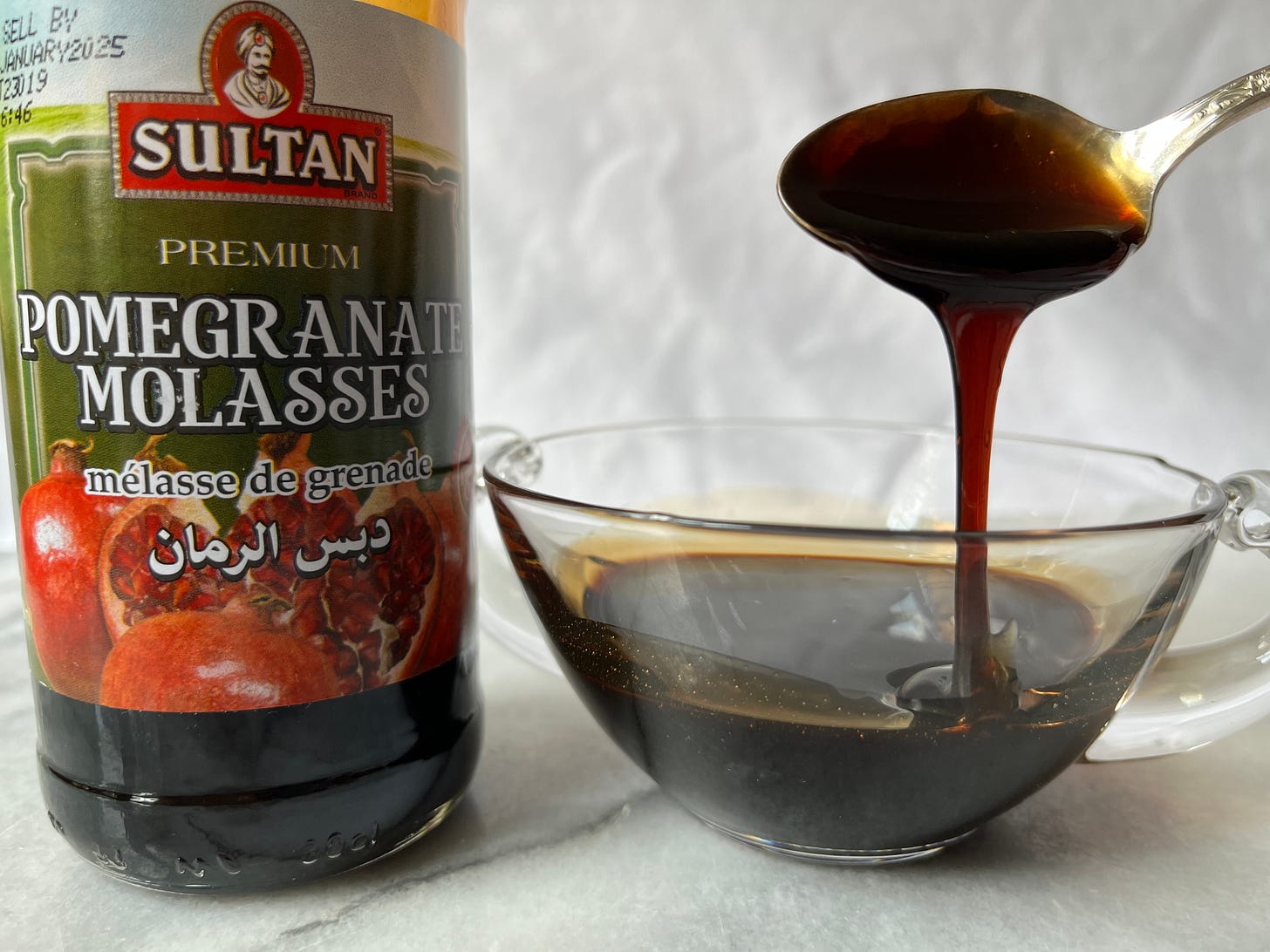Pomegranate Molasses Glazed Salmon for Two
It’s dinner for two tonight. Heart-healthy, omega 3-packed salmon is marinated and basted with a pomegranate molasses glaze that is off the charts delicious.
I have a new spin on a delicious glaze for baked salmon. Forget the maple syrup, forget the honey, we’re going with pomegranate molasses. The glaze for this recipe, which also serves as the marinade, has just three ingredients – pomegranate molasses, agave syrup, and Dijon mustard. If pomegranate molasses (sometimes referred to as pomegranate syrup) isn’t in your pantry, I highly recommend getting a bottle.
Pomegranate molasses is simply pomegranate juice that has been cooked down and reduced to a thick, sticky, reddish-brown syrup. The term “molasses” is a bit confusing. While the color and consistency are similar to molasses, it does not contain molasses.
If you’ve ever had pomegranate juice or seeds, you’re familiar with the sweet and pleasantly sour flavor this fruit offers. However, pomegranate molasses is tart and tangy, with a sweetness that’s more caramelized than fruity. The flavor is rich, intense, and complex. It’s unlike anything I’ve ever tasted, and I absolutely love it. I can’t believe it took me 20 plus years of recipe testing to discover it.
It’s a common ingredient used in Middle Eastern cooking. Dishes like fesenjan (Persian chicken stew), muhammara (roasted red pepper dip), kisir (Turkish bulgur salad), and fattoush (vegetable salad with toasted or fried flatbread) wouldn’t be the same without pomegranate molasses. Beyond these traditional dishes, pomegranate molasses can be swirled into salad dressings and vinaigrettes; whisked into marinades for meat, poultry and fish; brushed onto roasted vegetables; stirred into iced tea and lemonade; or drizzled over hummus and other dips. I’ve even been enjoying it on plain Greek yogurt with some granola.
Pomegranate molasses is easier to find than you might think. My local Middle Eastern market actually had five different brands to choose from. The Italian specialty market I frequent had three different brands. I also checked my grocery store and lo and behold, they had it too. Look for it in the international foods aisle. A 10-ounce bottle was $2.69. While some brands list concentrated pomegranate juice as the only ingredient, most options I came across contained pomegranate juice, citric acid (food preservative found naturally in citrus fruits), sugar, and water.
Store unopened pomegranate molasses in your pantry. Once opened, I like keeping it in the refrigerator. You may notice that the syrup thickens slightly in the fridge. It will return to its normal consistency if left at room temperature for about 5 minutes. For the best flavor, use it within a year of opening.
To your health,
Darlene
POMEGRANATE MOLASSES GLAZED SALMON for TWO
Yield: 2 servings
Serving Size: 1 salmon fillet
Prep: 10 minutes
Ready: 55 minutes
INGREDIENTS
2 (5 ounces each) salmon fillets
2 tablespoons pomegranate molasses
2 tablespoons agave syrup
2 teaspoons Dijon mustard
1/4 teaspoon black sesame seeds
2 tablespoons sliced green onion
Lemon wedges
DIRECTIONS
For easy cleanup, line an entire 8-inch square baking dish with foil. Place salmon fillets on top of foil and pat dry with paper towel.
In a small bowl, whisk together pomegranate molasses, agave syrup, and mustard until combined. Remove 2 tablespoons of glaze and place in a separate container (this reserved glaze will be used as a finishing sauce and drizzled over the cooked salmon). Brush tops and sides of salmon fillets with remaining glaze. Place baking dish in refrigerator and allow salmon to marinate for 30 minutes.
Place oven rack in center of oven and preheat to 400 degrees. Bake salmon for 5 minutes. Remove from oven and baste fillets with glaze that has collected in the pan. Return to oven and continue to bake until an internal temperature of 145 degrees is reached in the thickest part of the fillet; about 6 to 10 minutes.
When ready to serve, drizzle each salmon fillet with 1 tablespoon reserved glaze and sprinkle with 1/8 teaspoon sesame seeds and 1 tablespoon sliced green onion. Garnish with lemon wedges.
Nutrition Information per Serving
313 Calories, 10 g Total fat, 1 g Saturated fat, 0 g Trans fat, 81 mg Cholesterol, 150 mg Sodium, 25 g Total carbohydrate, 0 g Dietary fiber, 21 g Total sugars, 21g Added sugars, 29 g Protein, 0 mcg (0%) Vitamin D, 45 mg (4%) Calcium, 2 mg (10%) Iron, 734 mg (15%) Potassium
© 2023 RECIPES MADE HEALTHY BY DARLENE ZIMMERMAN, MS, RD LLC









Thanks Sheryl! I do love the sauce in this recipe. And you’re right, it would be good on pork and chicken as well 😋.
Hi Sheryl. Great question about the agave syrup substitution in the salmon glaze. You could use honey, maple syrup or even a little brown sugar. If you try brown sugar I might mix the pomegranate molasses with 1 or 2 tablespoons of brown sugar and heat it over low heat on your stovetop in a small pan just until the sugar dissolves. Let the mixture cool to room temperature, add the Dijon and glaze your salmon. Let me know if you try one of alternatives and how it went.